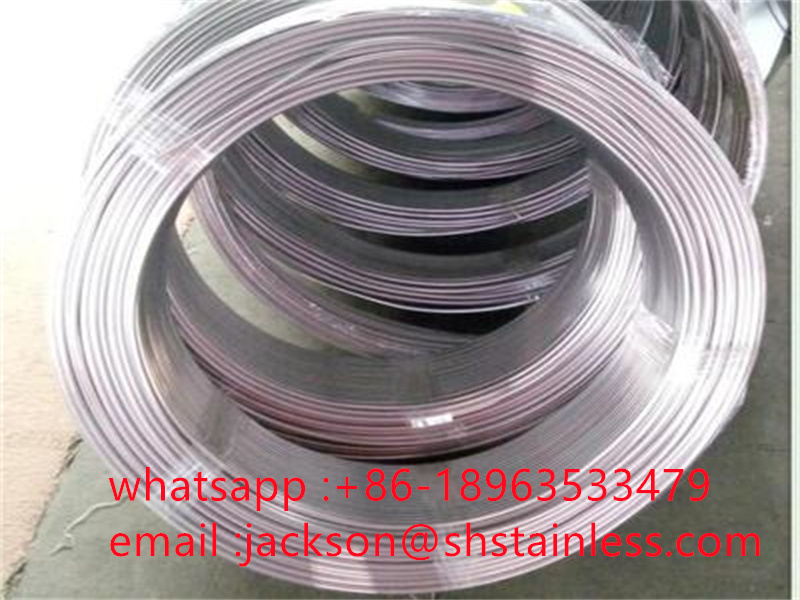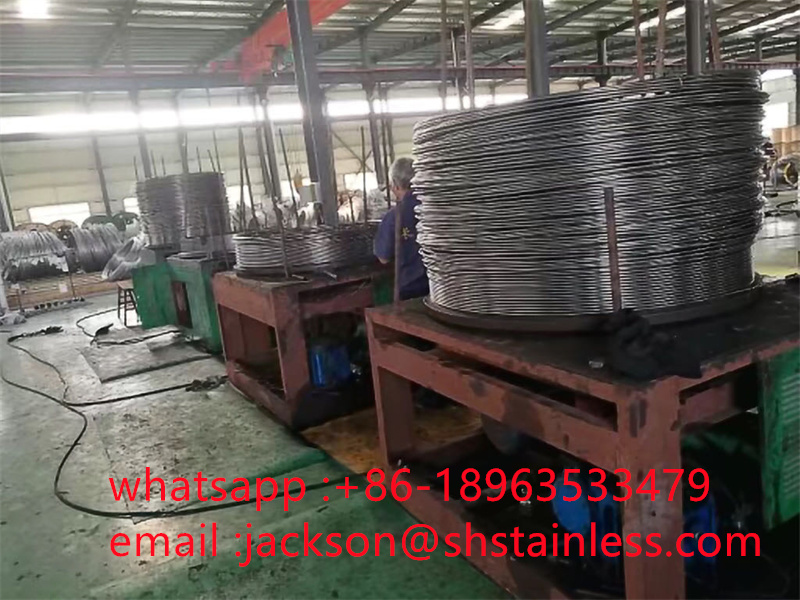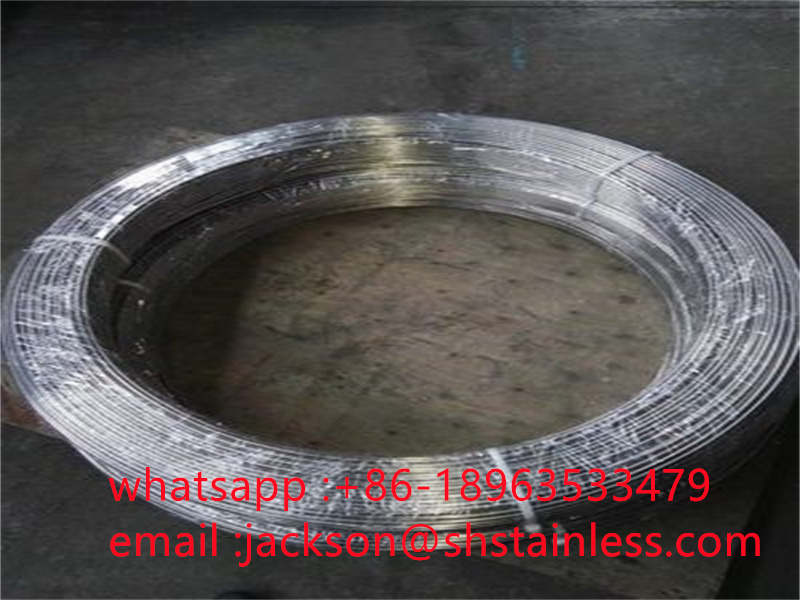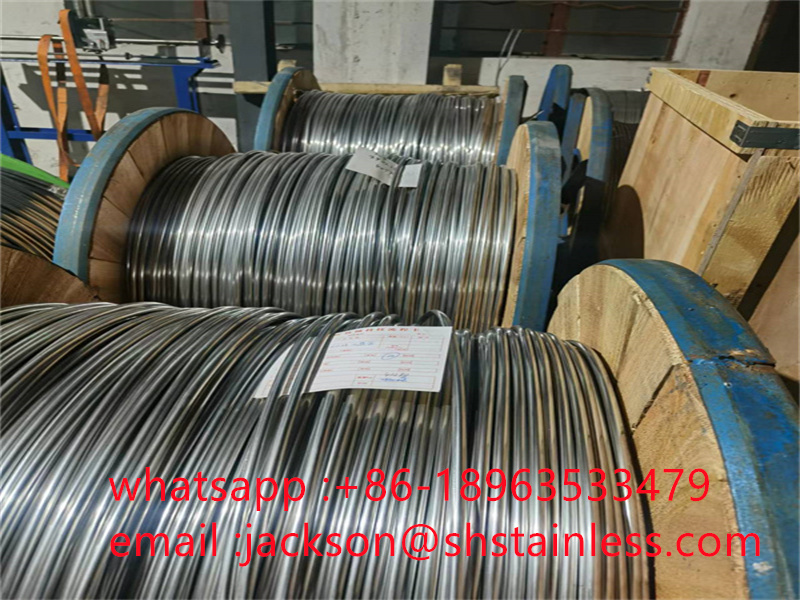Microchannel coils were used for a long time in the automotive industry before they appeared in HVAC equipment in the mid-2000s. Since then, they have become increasingly popular, especially in residential air conditioners, because they are lightweight, provide better heat transfer, and use less refrigerant than traditional finned tube heat exchangers.
However, using less refrigerant also means that more care must be taken when charging the system with microchannel coils. This is because even a few ounces can degrade the performance, efficiency, and reliability of a cooling system.
304 and 316 SS capillary Coil Tubes supplier in china
There are different material grades that are used for the coiled tubing for heat exchangers, boilers, super heaters and other high temperature applications that involve heating or cooling. The different types include the 3/8 coiled stainless steel tubing as well. Depending on the nature of the application, the nature of fluid that is being transmitted through the tubes and the material grades, these types of tubes differ. There are two different dimensions for the coiled tubes as the diameter of the tube and the diameter of the coil, the length, wall thickness and the schedules. The SS Coil Tubes are used in different dimensions and grades depending on the application requirements. There are high alloy materials and other carbon steel materials that are available for the coil tubing as well.
Chemical Compatibility of Stainless Steel Coil Tube
| Grade | C | Mn | Si | P | S | Cr | Mo | Ni | N | Ti | Fe | |
| 304 | min. | 18.0 | 8.0 | |||||||||
| max. | 0.08 | 2.0 | 0.75 | 0.045 | 0.030 | 20.0 | 10.5 | 0.10 | ||||
| 304L | min. | 18.0 | 8.0 | |||||||||
| max. | 0.030 | 2.0 | 0.75 | 0.045 | 0.030 | 20.0 | 12.0 | 0.10 | ||||
| 304H | min. | 0.04 | 18.0 | 8.0 | ||||||||
| max. | 0.010 | 2.0 | 0.75 | 0.045 | 0.030 | 20.0 | 10.5 | |||||
| SS 310 | 0.015 max | 2 max | 0.015 max | 0.020 max | 0.015 max | 24.00 26.00 | 0.10 max | 19.00 21.00 | 54.7 min | |||
| SS 310S | 0.08 max | 2 max | 1.00 max | 0.045 max | 0.030 max | 24.00 26.00 | 0.75 max | 19.00 21.00 | 53.095 min | |||
| SS 310H | 0.04 0.10 | 2 max | 1.00 max | 0.045 max | 0.030 max | 24.00 26.00 | 19.00 21.00 | 53.885 min | ||||
| 316 | min. | 16.0 | 2.03.0 | 10.0 | ||||||||
| max. | 0.035 | 2.0 | 0.75 | 0.045 | 0.030 | 18.0 | 14.0 | |||||
| 316L | min. | 16.0 | 2.03.0 | 10.0 | ||||||||
| max. | 0.035 | 2.0 | 0.75 | 0.045 | 0.030 | 18.0 | 14.0 | |||||
| 316TI | 0.08 max | 10.00 14.00 | 2.0 max | 0.045 max | 0.030 max | 16.00 18.00 | 0.75 max | 2.00 3.00 | ||||
| 317 | 0.08 max | 2 max | 1 max | 0.045 max | 0.030 max | 18.00 20.00 | 3.00 4.00 | 57.845 min | ||||
| SS 317L | 0.035 max | 2.0 max | 1.0 max | 0.045 max | 0.030 max | 18.00 20.00 | 3.00 4.00 | 11.00 15.00 | 57.89 min | |||
| SS 321 | 0.08 max | 2.0 max | 1.0 max | 0.045 max | 0.030 max | 17.00 19.00 | 9.00 12.00 | 0.10 max | 5(C+N) 0.70 max | |||
| SS 321H | 0.04 0.10 | 2.0 max | 1.0 max | 0.045 max | 0.030 max | 17.00 19.00 | 9.00 12.00 | 0.10 max | 4(C+N) 0.70 max | |||
| 347/ 347H | 0.08 max | 2.0 max | 1.0 max | 0.045 max | 0.030 max | 17.00 20.00 | 9.0013.00 | |||||
| 410 | min. | 11.5 | ||||||||||
| max. | 0.15 | 1.0 | 1.00 | 0.040 | 0.030 | 13.5 | 0.75 | |||||
| 446 | min. | 23.0 | 0.10 | |||||||||
| max. | 0.2 | 1.5 | 0.75 | 0.040 | 0.030 | 30.0 | 0.50 | 0.25 | ||||
| 904L | min. | 19.0 | 4.00 | 23.00 | 0.10 | |||||||
| max. | 0.20 | 2.00 | 1.00 | 0.045 | 0.035 | 23.0 | 5.00 | 28.00 | 0.25 | |||
Mechanical Properties Chart of Stainless Steel Tubing Coil
| Grade | Density | Melting Point | Tensile Strength | Yield Strength (0.2%Offset) | Elongation |
| 304/ 304L | 8.0 g/cm3 | 1400 °C (2550 °F) | Psi 75000 , MPa 515 | Psi 30000 , MPa 205 | 35 % |
| 304H | 8.0 g/cm3 | 1400 °C (2550 °F) | Psi 75000 , MPa 515 | Psi 30000 , MPa 205 | 40 % |
| 310 / 310S / 310H | 7.9 g/cm3 | 1402 °C (2555 °F) | Psi 75000 , MPa 515 | Psi 30000 , MPa 205 | 40 % |
| 306/ 316H | 8.0 g/cm3 | 1400 °C (2550 °F) | Psi 75000 , MPa 515 | Psi 30000 , MPa 205 | 35 % |
| 316L | 8.0 g/cm3 | 1399 °C (2550 °F) | Psi 75000 , MPa 515 | Psi 30000 , MPa 205 | 35 % |
| 317 | 7.9 g/cm3 | 1400 °C (2550 °F) | Psi 75000 , MPa 515 | Psi 30000 , MPa 205 | 35 % |
| 321 | 8.0 g/cm3 | 1457 °C (2650 °F) | Psi 75000 , MPa 515 | Psi 30000 , MPa 205 | 35 % |
| 347 | 8.0 g/cm3 | 1454 °C (2650 °F) | Psi 75000 , MPa 515 | Psi 30000 , MPa 205 | 35 % |
| 904L | 7.95 g/cm3 | 1350 °C (2460 °F) | Psi 71000 , MPa 490 | Psi 32000 , MPa 220 | 35 % |
SS Heat Exchanger Coiled Tubes Equivalent grades
| STANDARD | WERKSTOFF NR. | UNS | JIS | BS | GOST | AFNOR | EN |
| SS 304 | 1.4301 | S30400 | SUS 304 | 304S31 | 08Х18Н10 | Z7CN18‐09 | X5CrNi18-10 |
| SS 304L | 1.4306 / 1.4307 | S30403 | SUS 304L | 3304S11 | 03Х18Н11 | Z3CN18‐10 | X2CrNi18-9 / X2CrNi19-11 |
| SS 304H | 1.4301 | S30409 | – | – | – | – | – |
| SS 310 | 1.4841 | S31000 | SUS 310 | 310S24 | 20Ch25N20S2 | – | X15CrNi25-20 |
| SS 310S | 1.4845 | S31008 | SUS 310S | 310S16 | 20Ch23N18 | – | X8CrNi25-21 |
| SS 310H | – | S31009 | – | – | – | – | – |
| SS 316 | 1.4401 / 1.4436 | S31600 | SUS 316 | 316S31 / 316S33 | – | Z7CND17‐11‐02 | X5CrNiMo17-12-2 / X3CrNiMo17-13-3 |
| SS 316L | 1.4404 / 1.4435 | S31603 | SUS 316L | 316S11 / 316S13 | 03Ch17N14M3 / 03Ch17N14M2 | Z3CND17‐11‐02 / Z3CND18‐14‐03 | X2CrNiMo17-12-2 / X2CrNiMo18-14-3 |
| SS 316H | 1.4401 | S31609 | – | – | – | – | – |
| SS 316Ti | 1.4571 | S31635 | SUS 316Ti | 320S31 | 08Ch17N13M2T | Z6CNDT17‐123 | X6CrNiMoTi17-12-2 |
| SS 317 | 1.4449 | S31700 | SUS 317 | – | – | – | – |
| SS 317L | 1.4438 | S31703 | SUS 317L | – | – | – | X2CrNiMo18-15-4 |
| SS 321 | 1.4541 | S32100 | SUS 321 | – | – | – | X6CrNiTi18-10 |
| SS 321H | 1.4878 | S32109 | SUS 321H | – | – | – | X12CrNiTi18-9 |
| SS 347 | 1.4550 | S34700 | SUS 347 | – | 08Ch18N12B | – | X6CrNiNb18-10 |
| SS 347H | 1.4961 | S34709 | SUS 347H | – | – | – | X6CrNiNb18-12 |
| SS 904L | 1.4539 | N08904 | SUS 904L | 904S13 | STS 317J5L | Z2 NCDU 25-20 | X1NiCrMoCu25-20-5 |




The traditional finned tube coil design has been the standard used in the HVAC industry for many years. The coils originally used round copper tubes with aluminum fins, but the copper tubes caused electrolytic and anthill corrosion, leading to increased coil leaks, says Mark Lampe, product manager for furnace coils at Carrier HVAC. To solve this problem, the industry has turned to round aluminum tubes with aluminum fins to improve system performance and minimize corrosion. Now there is microchannel technology that can be used in both evaporators and condensers.
“The microchannel technology, called VERTEX technology at Carrier, is different in that round aluminum tubes are replaced with flat parallel tubes soldered to aluminum fins,” said Lampe. “This distributes the refrigerant more evenly over a wider area, improving heat transfer so the coil can operate more efficiently. While microchannel technology was used in residential outdoor condensers, VERTEX technology is currently only used in residential coils.”
According to Jeff Preston, director of technical services at Johnson Controls, the microchannel design creates a simplified single-channel “in and out” refrigerant flow consisting of a superheated tube at the top and a subcooled tube at the bottom. In contrast, the refrigerant in a conventional finned tube coil flows through multiple channels from top to bottom in a serpentine pattern, requiring more surface area.
“The unique microchannel coil design provides excellent heat transfer coefficient, which increases efficiency and reduces the amount of refrigerant required,” said Preston. “As a result, devices designed with microchannel coils are often much smaller than high efficiency devices with traditional finned tube designs. This is ideal for space-constrained applications such as homes with zero lines.”
In fact, thanks to the introduction of microchannel technology, says Lampe, Carrier has been able to keep most indoor furnace coils and outdoor air conditioning condensers the same size by working with a round fin and tube design.
“If we hadn’t implemented this technology, we would have had to increase the size of the internal furnace coil to 11 inches high and would have had to use a larger chassis for the external condenser,” he said.
While microchannel coil technology is primarily used in domestic refrigeration, the concept is starting to catch on in commercial installations as demand for lighter, more compact equipment continues to grow, Preston said.
Because microchannel coils contain relatively small amounts of refrigerant, even a few ounces of charge change can affect system life, performance and energy efficiency, Preston says. This is why contractors should always check with the manufacturer about the charging process, but it usually involves the following steps:
According to Lampe, Carrier VERTEX technology supports the same set-up, charge and start-up procedure as round tube technology and does not require steps that are in addition to or different from the currently recommended cool-charge procedure.
“About 80 to 85 percent of the charge is in the liquid state, so in cooling mode that volume is in the outdoor condenser coil and line pack,” Lampe said. “When moving to microchannel coils with reduced internal volume (compared to round tubular fin designs), the difference in charge affects only 15-20% of the total charge, which means a small, hard-to-measure field of difference. That’s why the recommended way to charge the system is by subcooling, detailed in our installation instructions.”
However, the small amount of refrigerant in the microchannel coils can become a problem when the heat pump outdoor unit switches to heating mode, Lampe said. In this mode, the system coil is switched and the capacitor that stores most of the liquid charge is now the internal coil.
“When the internal volume of the indoor coil is significantly less than that of the outdoor coil, a charge imbalance can occur in the system,” said Lampe. “To solve some of these problems, Carrier uses a built-in battery located in the outdoor unit to drain and store excess charge in heating mode. This allows the system to maintain proper pressure and prevents the compressor from flooding, which can lead to poor performance as oil can build up in the internal coil.”
While charging a system with microchannel coils can require special attention to detail, charging any HVAC system requires accurately using the correct amount of refrigerant, Lampe says.
“If the system is overloaded, it can lead to high power consumption, inefficient cooling, leaks and premature compressor failure,” he said. “Similarly, if the system is undercharged, coil freezing, expansion valve vibration, compressor starting problems and false shutdowns can occur. Problems with microchannel coils are no exception.”
According to Jeff Preston, director of technical services at Johnson Controls, repairing microchannel coils can be challenging due to their unique design.
“Surface soldering requires alloy and MAPP gas torches that are not commonly used in other types of equipment. Therefore, many contractors will choose to replace coils rather than attempt repairs.”
When it comes to cleaning microchannel coils, it’s actually easier, says Mark Lampe, product manager for furnace coils at Carrier HVAC, because the aluminum fins of the finned tube coils bend easily. Too many curved fins will reduce the amount of air passing through the coil, reducing efficiency.
“Carrier VERTEX technology is a more robust design because the aluminum fins sit slightly below the flat aluminum refrigerant tubes and are brazed to the tubes, meaning brushing doesn’t change the fins significantly,” Lampe said.
Easy Cleaning: When cleaning microchannel coils, use only mild, non-acidic coil cleaners or, in many cases, just water. (provided by the carrier)
When cleaning microchannel coils, Preston says avoid harsh chemicals and pressure washing, and instead use only mild, non-acidic coil cleaners or, in many cases, just water.
“However, a small amount of refrigerant requires some adjustments in the maintenance process,” he said. “For example, due to the small size, the refrigerant cannot be pumped out when other components of the system need service. In addition, the instrument panel should only be connected when necessary to minimize disruption of the refrigerant volume.”
Preston added that Johnson Controls is applying extreme conditions at its Florida proving ground, which has spurred the development of microchannels.
“The results of these tests allow us to improve our product development by improving several alloys, pipe thicknesses and improved chemistries in the controlled atmosphere brazing process to limit coil corrosion and ensure optimal levels of performance and reliability are achieved,” he said. “The adoption of these measures will not only increase homeowner satisfaction, but will also help minimize maintenance needs.”
Joanna Turpin is a senior editor. She can be contacted at 248-786-1707 or email joannaturpin@achrnews.com. Joanna has been with BNP Media since 1991, initially heading the company’s technical books department. She holds a bachelor’s degree in English from the University of Washington and a master’s degree in technical communications from Eastern Michigan University.
Sponsored Content is a special paid section where industry companies provide high-quality, unbiased, non-commercial content on topics of interest to ACHR’s news audience. All sponsored content is provided by advertising companies. Interested in participating in our sponsored content section? Contact your local representative.
On Demand In this webinar, we will learn about the latest updates to the R-290 natural refrigerant and how it will impact the HVACR industry.
Post time: Apr-24-2023
